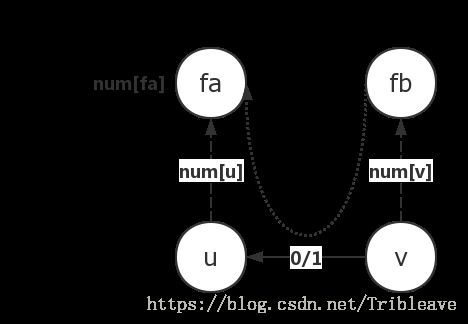并查集与带权并查集
-
- 并查集算法
- 概要
- 算法
- 路径压缩
- 时间复杂度
- 具体实现
- [POJ 2236] Wireless Network
- 带权并查集
- 概要
- 统计
- [POJ 1988] Cube Stacking
- [HDU 3635] Dragon Balls
- 区间统计
- [HDU 3038] How Many Answers Are Wrong
- [POJ 1733] Parity game
- 种类并查集
- [HDU 3047] Zjnu Stadium
- [POJ 1182] 食物链
- [POJ 2912] Rochambeau
- [POJ 1703] Find them, Catch them
- [POJ 2492] A Bug’s Life
- 其他与并查集相关的问题
- 逆向并查集
- [HDU 4496] D-City
- 可持久化并查集
- [BZOJ 3673] 可持久化并查集 by zky
- [BZOJ 3674] 可持久化并查集加强版
- 其他杂题
- [UVA 11987] Almost Union-Find
- [UVALive 4487] Exclusive-OR
- [CodeForces 813F] Bipartite Checking
- 逆向并查集
- 并查集算法
并查集算法
概要
并查集作为算法竞赛中较为简单、易用的数据结构,适用于由时序并入的动态集合查找。并查集中的两个主要操作就是“合并集合”与“查找集合”
算法
用集合中的某个元素来代表这个集合,该元素称为集合的代表元。
一个集合内的所有元素组织成以代表元为根的树形结构。
在并查集算法中,合并操作是将该元素所在树连接在被合并元素所在树上。
对于查找操作,即是路经查找到树根,确定代表元的过程。
判断两个元素是否属于同一集合,只需要看他们的代表元是否相同即可。
路径压缩
对于不相交集合的操作,一般采用两种启发式优化的方法:
1. 按秩合并:使包含较少结点的树根指向包含较多结点的树根。
2. 路径压缩:使路径查找上的每个点都直接指向根结点。
在大多数场景中,路径压缩就能满足时间要求。
时间复杂度
对于有 n n 项, m m 次操作的并查集(其中有 f f 次查询),运行时间时间复杂度为:
1. 朴素的并查集: O(n2) O ( n 2 )
2. 带按秩合并的并查集: O(mlgn) O ( m lg n )
3. 带路径压缩的并查集: O(n+f⋅(log2+f/nn)) O ( n + f ⋅ ( log 2 + f / n n ) )
4. 带路径压缩的按秩合并并查集: O(mα(n)) O ( m α ( n ) )
其中 α(n) α ( n ) 为Ackerman函数反函数,对于实际运用中,可认为 α(n)≤4 α ( n ) ≤ 4
具体实现
void init(int n) { for (int i = 0; i <= n; i++) { f[i] = i; rank[i] = 0;} }
int find(int x) { return x == f[x] ? x : f[x] = find(f[x]); }
void union(int x, iny y){
x = find(x), y = find(y);
if(x != y){
if(rank[x] > rank[y]) f[y] = x;
else{
f[x] = y;
if(rank[x] == rank[y])
rank[y]++;
}
}
}[POJ 2236] Wireless Network
注意在合并时,我们只需考虑这台电脑与之前已经修复的电脑能否通讯。
#include 带权并查集
概要
在并查集的基础上,对其中的每一个元素赋有某些值。在对并查集进行路径压缩和合并操作时,这些权值具有一定属性,即可将他们与父节点的关系,变化为与所在树的根结点关系。
统计
[POJ 1988] Cube Stacking
我们需要新增两种属性 cnt[i] c n t [ i ] 与 s[i] s [ i ] ,分别表示 i i 之下的块数和 i i 所在堆的数量。在路径压缩时,cnt[i] += cnt[f[i]] ,另外在连接操作时,需要动态更新cnt[find(u)]和s[find(v)]的信息。
#include [HDU 3635] Dragon Balls
我们需要新增两种属性 cnt[i] c n t [ i ] 和 trans[i] t r a n s [ i ] ,分别表示该堆数量和转移次数。在路径压缩时,trans[x] += trans[fa]。在合并时,动态更新被合并树的堆数量,并增加合并树的转移次数cnt[fy] += cnt[fx],trans[fx++]。
#include 区间统计
[HDU 3038] How Many Answers Are Wrong
需要注意:
1. 此类问题需要对所有值统计设置相同的初值,但初值的大小一般没有影响。
2. 对区间[l, r]进行记录时,实际上是对 (l-1, r]操作,即l = l - 1。(即势差是在l-1和r之间)
3. 在进行路径压缩时,可和统计类问题相似的cnt[x] += cnt[fa](因为势差是直接累计到根结点的)
4. 在合并操作中,对我们需要更新cnt[fb](由于fb连接到了fa上),动态更新的公式是cnt[fb] = cnt[u - 1] - cnt[v] + d,为了理解这个式子,我们进行如下讨论:
- 更新cnt[fb]的目的是维护被合并的树(fb)相对于合并树(fa)之间的势差。
- cnt[fb] - cnt[fa]两者之间的关系,并不能直接建立,而是通过cnt[u - 1] - cnt[v]之间的关系建立。
- 可知 cnt[v]保存结点v与结点fb之间的势差; cnt[u-1]保存结点u-1与结点fa之间的势差;d是更新信息中结点u-1与结点v之间的势差
- 所以cnt[fb]的值为从结点fb与结点v(-cnt[v]),加上从结点v到结点u(d),最后加上从结点u-1到结点fa(cnt[u - 1])
#include [POJ 1733] Parity game
与上一题类似,由于数据范围较大,需要首先进行离散化。由于只有奇偶两种状态,所以只需要用0和1表示状态即可。在路径压缩时num[x] = num[x] ^ num[fa](模2系)
#include 种类并查集
[HDU 3047] Zjnu Stadium
注意到座位编号是1~300,所以是一个模300系。相对于区间统计类的并查集,这里的pos[i]可以被理解为每个人的种类。其他操作类似于区间统计类的并查集。
#include [POJ 1182] 食物链
可参考:http://blog.csdn.net/c0de4fun/article/details/7318642
对于这三种种类,同类可以用0表示,其他两种分别用1表示该结点被父节点吃,2表示该节点吃父节点。
该题之所以能用并查集进行路径压缩,是因为存在A吃B,B吃C,C吃A的三角关系。这是我们能在路径压缩中使用num[x] = (num[x] + num[fa]) % 3和更新时使用num[fb] = (3 - num[v] + num[u] + (p - 1)) % 3的原因(否则就是一种链式关系了)。

关于num[fb] = (3 - num[v] + num[u] + (p - 1)) % 3的推导,我们可以画图来理解。
我们能够获得的信息是num[fa] num[u] num[v]与u v之间的关系,有一个很好的性质就是在该模3系中,关系是可以逆推的,即如果把从v到fb的链反向,那么fb相对于v的关系就是3-num[v]
如图所示,我们在这些关系的基础上,要获得fb相对于fa的关系,直接将“关系”进行(反转)相加即可。
#include [POJ 2912] Rochambeau
基础操作与食物链非常相似,但是有可能出现一个或多个异常。在以下方法中,我们枚举每个人是异常的情况,观察有多少个人可能是裁判。如果有多个人成为裁判使体系融洽,那么不能确定;如果没有一个人成为裁判后体系融洽,那么就没有答案;如果只有一个人可能成为裁判,那么我们得出判断的轮数,就是其他人成为裁判时,使体系不融洽的最大轮数。
#include [POJ 1703] Find them, Catch them
模2系,只需注意最后三种情况的判断。
#include [POJ 2492] A Bug’s Life
#include 其他与并查集相关的问题
逆向并查集
[HDU 4496] D-City
由于题目的特殊性,我们可以逆向构建并查集。初始化cnt = n如果发现两者不属于同一集合,有cnt–。对于每一步,有ans[i - 1] = cnt
#include 可持久化并查集
[BZOJ 3673] 可持久化并查集 by zky
[BZOJ 3674] 可持久化并查集加强版
http://blog.csdn.net/lemonoil/article/details/57085830
http://blog.csdn.net/lemonoil/article/details/57085381
http://blog.csdn.net/lemonoil/article/details/57416510
http://blog.csdn.net/kscla/article/details/53586880
http://blog.csdn.net/iamzky/article/details/38349183
(待填坑)
其他杂题
[UVA 11987] Almost Union-Find
[UVALive 4487] Exclusive-OR
[CodeForces 813F] Bipartite Checking
(待填坑)